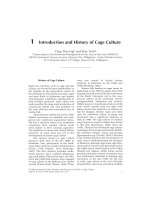Tài liệu Nature and Properties of Micro-organisms doc
Bạn đang xem bản rút gọn của tài liệu. Xem và tải ngay bản đầy đủ của tài liệu tại đây (1.83 MB, 35 trang )
Nature and Properties
of Micro-organisms
Laura JV Piddock
Smallest to largest…..
Prions
Viruses
Bacteria
Fungi
Prions
Infectious protein
No DNA or RNA
Normal cellular form of protein vs.
pathological form
Pathological form
found in neural
tissue and tonsils
PrP-C & PrP-Sc
Pathology
Spongiform
encephalopathy:
transmissible, familial
Transmission: oral,
operative (neural
tissue, dura,
corneas), ??? blood
Resistance to
disinfectants
Formaldehyde
increases infectivity
Viruses
DNA or RNA
Shell of protein (capsid) surrounding nucleic
acid
Classification on basis of nucleic acid
DNA viruses: eg Herpes simplex virus
(HSV)
RNA viruses: eg influenza virus
DNA viruses: herpes simplex virus (HSV)
RNA viruses: Influenza
Viruses
Obligate intracellular parasites
Use host cell for nucleic acid and
protein synthesis
Cell attachment: target for blocking
antibody vaccines
Intracellular replication: target for
antiviral drugs
n.b. retroviruses (RNA) e.g. HIV
RNA
DNA
Viral effects on host cells
Degeneration (cytopathic effect): CMV
Cell lysis
Cell fusion, syncytia formation: RSV
Cell proliferation
Transformation: malignancy (parvoviruses)
Latent infection - no sign of infection until
reactivation
‘cold sores’ (HSV)
chickenpox shingles (VZV)
CMV hepatitis
owl eye effect inclusion body
Varicella zoster virus (VZV)
VZV: Chickenpox
VZV: Shingles
Re-activation of
latent infection
Suppression of
cell mediated
immunity
Bacteria
Unicellular, prokaryotes
DNA and RNA
Binary fission
No mitochondria
Rigid cell wall containing
peptidoglycan
Eubacteria
Classified according to:
size & shape
cell wall (Gram stain)
aerotolerance
Gram stain reaction
positive - purple
negative - pink
Shape
coccus - round (chains?
clusters?)
bacillus - rod
Wound swab: S. aureus









